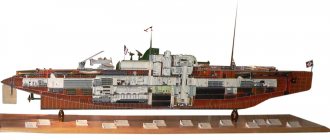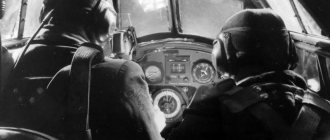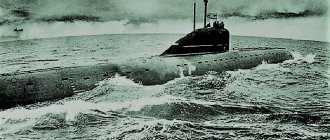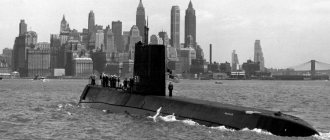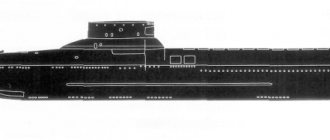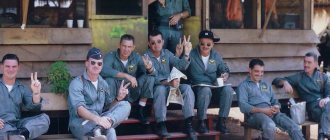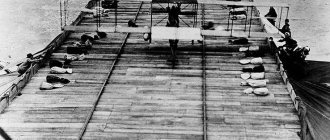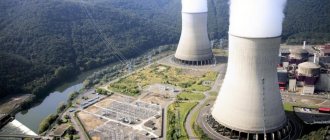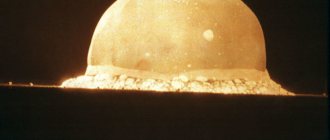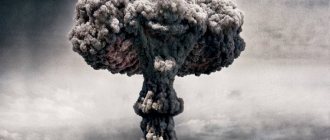On August 29, 1949, an event occurred that at first only a few insiders knew about. But it influenced the destinies of millions of people around the world. The first test of atomic weapons took place in the Soviet Union. Everything went flawlessly. This date is one of the key dates in our history. A sign of reaching a new level of development of civilization, a new level of power. This day marked the end of the United States' nuclear monopoly. The world has lost its unipolarity. Of course, even before the Semipalatinsk explosion, the Soviet Union was an independent player in political chess. But only big science turned our country into a real superpower. Details are in the Izvestia article.
Marshal and academician
The Soviet nuclear project had many political curators - Vyacheslav Molotov, Georgy Malenkov, Boris Vannikov, Mikhail Pervukhin. But when the matter required efficiency, Lavrentiy Beria pushed everyone aside. Intelligence worked for the atomic project, prisoners worked. In addition, it was necessary to cover dozens of enterprises scattered throughout the country with an invisible dome of secrecy. Only a marshal from the NKVD could cope with such a task.
From science, the project was headed by Igor Kurchatov, the most unclassified (he was allowed to speak publicly under his own name!) of the scientists of such a sensitive direction.
Photo: TASS/S. Ivanov-Alliluyev
Igor Vasilievich Kurchatov. 1950
Why did the party and government entrust such an important task to him, not the most honored scientist at that time? The decisive role was played by the patronage of Abram Ioffe, a venerable academician who, without exaggeration, created the Soviet physics school. “Papa Ioffe” saw in Kurchatov not only research tenacity and determination, but also remarkable organizational skills. In addition, he was relatively young and knew how to work hard. He, forty years old, should have been enough for 10–20 years of extreme stress.
The competent authorities have prepared for the non-party academician Comrade. Kurchatov has the following description: “In the field of atomic physics, Kurchatov is currently the leading scientist of the USSR. He has great organizational skills and is energetic. By nature, the person is secretive, cautious, cunning and a great diplomat.”
Photo: P. Fedotov
Abram Fedorovich Ioffe in the laboratory of thermal devices of semiconductors. 1960
The first bomb: the history of the creation of nuclear weapons - in detail
Soviet physicists achieved parity of strategic weapons already in 1949
A little later, it was Kurchatov who became the most energetic promoter of the “peaceful atom”. The appearance of such unique phenomena as the world's first Obninsk nuclear power plant and the nuclear icebreaker "Lenin" is largely due to his merit. Kurchatov believed that nuclear physics could help not only in destroying and intimidating the enemy, but also in industrial creation. “The atom should be a worker, not a soldier,” the scientist, whom the whole country knew by his long beard, used to say.
"Top secret"
The Decree of the Council of Ministers of the USSR No. 2493-1045ss/op dated November 14, 1946 stated “the need to build a special testing ground for RDS,” which will henceforth be called the “Mining Station of the First Main Directorate.” The main objective of the research is “the practical use of the RDS mine forge.”
If you lift the veil of secrecy, then everything becomes clear.
"Mountain Station" is a testing ground.
"RDS" - atomic bomb.
"Mine horn" - a nuclear charge.
The Kazakh steppes were ideal both for testing weapons and for preserving all kinds of secrets. Control over the work of designers and physicists was extremely strict. They had to constantly report to the country's top leadership about their every step, about conducting certain experiments, about successes and failures.
RDS-1. Photo: https://www.biblioatom.ru
The secrecy of the “Atomic Project” was special for each person, and therefore is described by the participants in the events differently. Thus, Professor L.V. Altshuler is one of the pioneers of the “Atomic Project”. In his memoirs about the “lost world of Khariton” (as he calls the design bureau, where the first models of nuclear weapons were created), he writes: “The secrecy regime was also depressing. It was not just a regime, but a way of life that determined the behavior, way of thinking of people, their state of mind. I was haunted by the same dream, from which I woke up in a cold sweat. I dreamed that I was in Moscow, walking down the street and carrying SS documents in my briefcase (top secret). And I understand that I died, because I cannot explain how and for what purpose they got there. But it's just a dream. And once almost the same thing happened to me in reality. Coming home from work in the evening (fortunately, not in Moscow, but at the site) and unwrapping the newspapers that were carefully delivered to us at work, I was horrified to discover among them secret documents that I was obliged to hand over at the end of the working day to the first department. However, instead, I absent-mindedly put them in my briefcase along with the newspapers. My first impulse was to report a violation of the secrecy regime. I was saved by my kind genius, my wife Maria Parfenyevna Speranskaya , who, by the way, was the first bomber of the facility. She categorically opposed this, realizing that honesty in this case was punishable, and very seriously. At night I kept the documents under my pillow, and in the morning, when I arrived at work first, I put them in the safe, after which I went to the regime department and “confessed” that yesterday I did not have time to hand over these documents and left them in the safe. The violation was forgiven."
"Beard" against America.
How Igor Kurchatov saved the USSR from an atomic strike More details Many people dreamed of their hometown Moscow in those years, since they no longer hoped to return there.
Lines from a song written by physicists unequivocally warned: “There is a plane from Moscow to Sarov, whoever gets here will not come back...” According to the laws of secrecy, people from the “Object” were not allowed not only on vacation, but also to the funeral of their father and mother... Article on this topic
The case of Pilot Powers. How the Soviet Union disgraced the US President
Particular attention was paid to the fight against spies. The Ministry of State Security was instructed to “organize enhanced operational security work at facility No. 859 and in areas of the Chelyabinsk region adjacent to the security zone.” All correspondence that came here or went out “to the big world” was censored. Flights of aircraft not only of civil aviation, but also of military aviation were prohibited. The first person to try to fly over the Plutonium Plant will be the American intelligence officer Powers . But this will happen after 15 years. The U-2 will be shot down by a missile near Sverdlovsk. By the way, the American intelligence officer will film not only the Plutonium Plant, but also Chelyabinsk-70, a nuclear weapons center. However, for another good 30 years the Americans will not know what they are doing in the city of Snezhinsk.
Ahead of time
Ioffe was perhaps the first in the scientific world to believe in the miraculous power of nuclear energy. True, he, like other scientists, believed back in the early 1930s that the first practical results in this area would have to wait decades. Everything changed shortly before the war, when scientists in several countries at once created a new direction in science - nuclear physics.
Photo: commons.wikimedia.org
State Defense Order No. 2352 ss of September 28, 1942 “On the organization of work on uranium”
In 1940, Georgy Flerov and Konstantin Petrzhak discovered the phenomenon of spontaneous fission of uranium. Soon, the Presidium of the USSR Academy of Sciences received a note “On the use of uranium fission energy in a chain reaction,” signed by Kurchatov, Flerov and other prominent specialists. An academic uranium commission was created.
But in the first months of the war, research had to be suspended: the country had more pressing needs, and the taming of the atom seemed like something almost fantastic. Work resumed only at the end of 1942 - when it became clear that the development of unprecedented deadly weapons in Nazi Germany and the USA was already posing a threat to our security. During this time, the Americans, who essentially employed the best physicists in the West, managed to get ahead.
Photo: commons.wikimedia.org
Zinaida Vasilievna Ershova
At the end of 1944, scientists demonstrated the first high-purity uranium ingot to the leadership of the USSR. This was largely the merit of the “Russian Madame Curie” Zinaida Ershova, who headed the corresponding laboratory at the Giredmet Institute of Rare Metals Industry. Of course, the newspapers did not write about this.
Atom Pioneers
How did the history of the Kurchatov Institute begin?
Transcript History of the Soviet atomic bomb
How scientists and military men built a new industry in four years, and how workers built a swimming pool in one night
Author Galina Orlova
There are different ways to tell the story of the bomb. Someone starts it with 1938 and the discoveries of Otto Hahn and Fritz Strassmann, who proved that a controlled nuclear reaction is possible. In 1944, Otto Hahn received the Nobel Prize in Chemistry for the discovery of the fission of heavy nuclei. When uranium is bombarded with neutrons, its nucleus disintegrates into several parts and a large amount of energy is released. This process of nuclear fission underlies the operation of nuclear reactors and nuclear weapons. . This is how the bomb fits into the world history of nuclear physics. Someone dates back to 1942–1943, showing that the achievements of Soviet foreign intelligence contributed to the unfreezing of work on the uranium problem. But most authors begin this story with August 1945, Hiroshima, the decision to create a Special Committee under the State Defense Committee and the First Main Directorate - the administrator of the Soviet nuclear industry and coordinator of work related to the bomb. Here the bomb becomes the response of the Soviet leadership and mobilized physicists to the beginning of the atomic age, the emerging confrontation between the USA and the USSR and the impending debut of the Cold War.
I will do differently and start this story with a foundation pit - perhaps because my first visit to the building on Bolshaya Ordynka, which housed the Soviet Ministry of Medium Engineering, or the secret atomic agency Sredmash, and then Rosatom, began with the word “pit”. It was shouted by an elderly man in a cap and leather jacket, very unlike the managers in blue suits and very similar to a former Soviet engineer and technical worker - an Itroite. He walked along the giant steps between the cyclopean ones, that is, huge ones. columns and shouted into the mobile phone: “Pit!” Thus, the word “pit” connected for me different times of the existence and development of the Soviet and Russian nuclear industries.
Maybe the “pit” reminds us of Platonov and the Soviet project - and it’s difficult to think about the atomic project without thinking about the Soviet project. Or maybe I’ll start with the pit because this is where big construction begins, and the construction of the Soviet nuclear industry was big.
In April 1947, only the pit for the first industrial reactor was ready. The spectacle is impressive: the depth is 54 meters, the diameter on the surface is 110 meters. But the finished cauldron is still far away, and yet Beria promised Stalin to complete construction near Kyshtym by November 7, 1947. By November 7, construction was not completed. , or the so-called “Annushka”, plant No. 817, where weapons-grade plutonium began to be produced, was put into operation on May 15, 1948. 45 thousand people took part in the construction: prisoners, military builders and civilians. The initial installation was completed in ten months. 1,400 tons of metal structures, 3.5 thousand tons of equipment, and so on were used.
This was the scale of power, since the first persons of the state and personally Lavrenty Pavlovich Beria, who headed the Special Committee and at that time held the post of Deputy Chairman of the Council of Ministers, were directly involved in the construction. It was a desire to fit construction into the Soviet symbolic order, to correlate it with the thirtieth anniversary of October. There was a joke among physicists that everyone dreams of discovering the next particle before the next congress.
However, it is important to say that the atomic project was not only integrated into Soviet reality, but also changed it. The bomb created two years later imposed its dimension on Soviet reality, deforming it and supporting new formats of cooperation, movement into the unknown, secrecy, ambitions, risks, diseases. The Soviet Union, which received the bomb, became a superpower and a major player in the international arena. And the physicists who made it received Stalin Prizes, lifelong pensions, made scientific careers and became the country's scientific elite.
The unusual thing about this construction project was that it had a scientific director - Academician Kurchatov. In addition to the academician, physicists worked at the plant and controlled the main production processes. Subsequently, physicists became part of the staff of the largest enterprises in the Soviet nuclear industry. Soviet Atomic Minister Efim Pavlovich Slavsky proudly said that he had an entire Academy of Sciences in his ministry, contrasting nuclear scientists with those areas where factories were headed by general designers and where the concentration of scientific resources is much weaker.
The scale and science intensity of the atomic project were largely due to the fact that too much was unknown at the beginning of the work and it was necessary to obtain an applied result too quickly. Therefore, where the role of inventor is usually played by an engineer, in the Soviet nuclear industry it was played by physicists - and often theoretical physicists, since it was necessary to imagine both fundamental processes and their applied research.
The concentration of resources, power and knowledge intensity gave a new scale to knowledge and changed the quality of its production. American physicist Alvin Weinberg, participant in the Manhattan Project The Manhattan Project is an American government program to create an atomic bomb. The program began in 1942 under the leadership of physicist Robert Oppenheimer and General Leslie Groves and was successful in 1945. The world's first atomic bomb was tested on July 16, 1945 in New Mexico. and the head of the Oak Ridge National Laboratory, which was one of the largest nuclear centers in the United States of America, called large-scale scientific and technical programs in the field of nuclear research, space exploration, and radio electronics big science. Weinberg spoke of reactors and accelerators as pyramids of the 20th century - objects that embodied the ambitions of their creators, the historical imagination of the era and the national prestige of the countries implementing such grandiose undertakings.
The question arises: how was great Soviet science born around the bomb - an experimental object with which no experiment could be carried out? What was its Soviet originality, besides the fact that the bomb in the USSR was not tested in real combat conditions, and prisoner labor was used for technical work and construction? How does this work of tension and imagination reveal the ancestral connection between the bomb and big science and the Cold War?
Soviet big science was not always big. If American physicists in 1940 introduced a moratorium on the publication of scientific works on nuclear fission and nuclear physics in general, then in the Soviet Union, work on nuclear physics was stopped altogether as unpromising in practical applications, and therefore unnecessary in the coming years. Nuclear physics is being taken beyond the boundaries of mobilized science.
The situation changes in 1942, when, in the wake of the start of the Manhattan Project and the arrival of new intelligence data, readers appear for this data. One of them was Igor Vasilyevich Kurchatov, Ioffe’s student Abram Fedorovich Ioffe (1880–1960), a Soviet physicist, a pioneer in semiconductor research and an honorary member of academic communities in the USSR and around the world. Ioffe, who stood at the origins of the physical school of the USSR, is called the “father of Soviet physics.” , head of the laboratory at the Leningrad Institute of Physics and Technology. The transformation of the head of the laboratory into the head of the Soviet atomic problem was an unexpected personnel decision and showed that the use of talented scientists in fast-growing projects is promising.
The result of reading the intelligence data was a resolution on the organization of work on uranium. Academician Ioffe was ordered to resume research in the field of nuclear physics. Initially, they were supposed to be resumed under the auspices of the USSR Academy of Sciences. On March 10, 1943, a decree was issued on the appointment of Kurchatov as the scientific director of work on the bomb, and on April 12, on the creation of Laboratory No. 2 of the USSR Academy of Sciences, the main scientific division of the atomic project.
Scientists had to play a major role in the implementation of this project, since too much was unknown. The first composition of the laboratory is 11 people. Kurchatov himself has been hanging around for a long time between the states of LPTI and the “two,” Laboratory No. 2. For the construction of the “two,” an area of 120 hectares is allocated in Moscow, where the mothballed construction site of the Institute of Experimental Medicine was located.
The filling for the bomb is planned to be made from two types of materials: plutonium-239, which does not exist in nature, for the production of which a plant is being built in the Southern Urals, and the existing isotope - uranium-235, which is contained in very small doses in natural uranium. Industry had to be invented and created from scratch. There was a noticeable problem with resources: something was found in Central Asia, but, according to physicists, at least 100 tons were required to start work on uranium and build reactors - in the immediate plans, calculations and access there were about ten.
It was then that a radiometrist would be included in every geological party, and in 1955 Alexander Gorodnitsky would sing:
He spent his life on uranium, He searched for it in the mountains for many years, And as a result of this life, He lost his loud voice.
In the meantime, plans to extract 100 tons by the end of 1944 remained on paper. One of the reports stated that the reason lay in lack of attention and poor logistics: uranium samples obtained by the Institute of Rare Metals were rejected by Comrade Kurchatov as unsuitable for experiments. The nuclear industry imposed unprecedented standards on both the people who performed the work and the materials they worked with.
It was during this period that specific mechanisms for financing the Soviet nuclear project were developed: so-called lump sum financing is used, when the bank allocates funds to solve the problem without specific projects and estimates, at uniform prices, in order, on the one hand, to speed up the solution of the problem, and on the other hand, not create additional privacy problems.
Thus, between 1942 and 1945 we are dealing with an atomic project on the scale of Laboratory No. 2 and a large number of problems faced by the laboratory staff and Academician Kurchatov personally.
The fall of 1945 is the time when the administrative design of the Soviet atomic project is invented. In August 1945, a structure was created to coordinate work in the Soviet atomic project: on August 20, a Special Committee was created under the leadership of Beria, and under this committee an administrative body was established to solve all practical problems in creating a bomb called the First Main Directorate - PGU.
This was not the first main directorate in the history of Soviet civilization: before that, in 1932, in order to solve the ambitious tasks of conquering the Soviet Arctic, the GUSMP, the Main Directorate of the Northern Sea Route, was created. However, the First Main Directorate, dealing with the atomic problem, had a very special status and a pronounced supra-departmental character: its members included the first and second officials of key Soviet ministries. This was a surefire way to provide leadership at scale, flexibility, and directness.
And 1945 is the time when the atomic project sharply increases in scale. In particular, the Main Directorate of Mining and Metallurgical Industry Camps and research institutes have been transferred to the PSU, separate laboratories are being formed, processes related to the exploration and production of uranium are being launched, factories are being re-equipped - including the use of German equipment and the involvement of German specialists. On May 2, 1945, Deputy Head of the First Main Directorate Abraham Zavenyagin flies to Germany, accompanied by leading Soviet physicists, to inspect the property of the Kaiser Wilhelm Institute of Physics. A great success was the discovery of 100 tons of uranium, which significantly corrected the resource problem of the Soviet nuclear project.
Thus, 1945 is the year of a dramatic change in scale. If at the end of August the key scientific participant in the atomic project was Laboratory No. 2, then by the end of the year about a hundred research organizations were already involved in the work on the atomic project. The First Main Directorate has laboratories, factories, testing grounds, mines, and entire cities. It functions as a state within a state, but a special place in this coordinate system is occupied by KB-11, or the city of Sarov, where the People's Commissariat of Ammunition plant was located until 1946. It is there that they decide to locate the main design bureau for the development of the atomic bomb.
On the basis of the Moscow Mechanical Institute (MMI), located in the building of the former Vkhutemas on Kirova Street, now Myasnitskaya, a structure is being created for training physics engineers for the tasks of Laboratory No. 2. In the future, this institute will be renamed MEPhI and will become the basis of Soviet atomic education. The atomic project needed not engineers or physicists, but physics engineers. The study lasts six years, and the programs include both fundamental physics and applied engineering courses. Teachers come directly from nuclear test sites, and students receive an increased stipend and, starting from the third year, study in secret: they write in secret notebooks handed over to the special unit, submit and defend secret theses, and do internships in nuclear laboratories.
When Soviet physicists demonstrate the achievements of Soviet atomic science and technology at the First Conference on the Peaceful Uses of Atomic Energy in Geneva in the summer of 1955, it will not be the model of the world's first nuclear power plant that will make the greatest impression on their foreign colleagues. There is no generally accepted point of view in the world as to who built the first a station operating on the basis of a nuclear reactor (for example, the EBR-1 reactor, which generated electricity, was built in the USA in 1951, but its power was only enough for a few light bulbs). The Obninsk station, launched three years later, was capable of producing electricity on an industrial scale. In this regard, in Russian-language literature this primacy (partly rhetorically) is shown in the title. and not the report of the director of the laboratory where this station was launched, but the scale of specialist training that the Soviet Union managed to achieve in a very short time. As soon as the atomic education project was launched in 1945, the best physicists were called from the country's leading universities in order to speed up the graduation of specialists as much as possible.
It is curious that if physicist engineers are absolutely always boys, a male contingent, then radiochemists are girls. Memorative texts about plutonium in girls’ hands are written specifically about women’s contribution to the implementation of the Soviet atomic program. Separation of isotopes and purification of weapons-grade plutonium is a very dirty job: “dirty” means “radiation hazardous.” In the early years, when sanitary standards had not yet been established and dosimetric equipment was not debugged, the number of employees of radiochemical production facilities receiving chronic radiation sickness was large.
And the science and technology that made it possible to create an atomic bomb in this short period of time is characterized by the following. Firstly, we are talking about direct contact with the authorities and the triumph of direct relationships over all kinds of bureaucratic intermediaries and structures. The history of relations between nuclear scientists and the authorities begins not in 1945, but in 1943, when the newly created Laboratory No. 2, which was formally assigned to the Academy of Sciences, was in fact not subordinate to it either organizationally or economically and was not dependent on it. She reported directly to the government: it approved plans and reports, and logistics were carried out through the NKVD.
This direct interaction with the authorities turns out to be very important both practically and symbolically for nuclear scientists. Great physicists develop a specific language for clearly speaking about complex things in order to explain to leaders why it is necessary to make one decision and not another. In the published archive of Kurchatov there is a recommendation on how to prepare reports for submission to the government - as simply as possible. This is a kind of prototype of modern presentations.
On the other hand, one cannot fail to mention the situation related to nuclear facilities that were located far from the capitals. In these places, Soviet and party power in the usual sense of the word is absent: all power belongs to the head of the Object, and party interests are represented by a direct representative of the Central Committee or the political department.
Secondly, we are talking about an unprecedented scale of secrecy. Not only in the Soviet Union, but also in the United States, the implementation of national nuclear programs is associated with the creation of special infrastructures and secrecy machines, previously unknown. Of course, secret knowledge and societies existed, if not always, then for a long time, but the scope, detail and clarity appear along with the atom.
From the first years of their existence, both industrial and scientific research secret facilities of the nuclear cycle are not just arranged in a regime, in the image and likeness of a zone, they are a zone. For example, by decree of the Council of Ministers of February 17, 1947, KB-11 - also known as Arzamas-16 - refers to especially secret security enterprises with the transformation of its territory into a closed zone. By May 1, 1947, the territory protection regime was supposed to come into effect. This means that in a short period of time, a territory with a total perimeter of 56.4 kilometers had to be transformed into a restricted area with its characteristic attributes: a regular perimeter, two or more security contours, watchtowers with sentries, a watch, a pass system, a fence, barbed wire, a palisade or a solid one. a wooden fence of sufficient strength, the barb on which should always be well tensioned. The cost of producing the security space for Arzamas-16 was about six million rubles. Making a zone is not a very cheap thing.
It is important to understand that security does not suddenly fall on a nuclear project. Throughout 1944–1946, NKVD officers supervising physicists regularly received complaints about poor discipline and non-compliance with regime requirements. For radiochemists working on the production of heavy water at the Karpov Institute of Physics and Chemistry, these requirements were of a very domestic nature: German specialists working at the Object were reprimanded for using a camera; They do not use special guards or security department employees as control, but their own senior researchers.
The situation changes in the summer of 1947: an updated law on the observance of state secrets is issued. This is the first time that scientific and technical topics and problems are included in the list of information representing state secrets. Inspections of premises and documents begin, and the daily routine of employees is tightened. There is only one step left before the transformation of research organizations into high-security facilities, to shooters at the doors of the laboratory, a separate pass to each room on the territory, encrypted nuclear terms, workbooks handed over to the First Department, and the horror of losing pages counted by someone - that is, before everything that became commonplace in the memories of scientists and engineers about working in the nuclear project in the early 50s.
It is important that large-scale Soviet nuclear science is not only burdened with regime requirements, but is also subject to the logic of secret knowledge production: encryption and concealment of information become an important part of scientific communication and significantly change the very process of knowledge production. There are closed academic councils, closed dissertation topics, secret courses. To travel to a secret conference, you need to submit your abstracts to the secure part of your institute and receive them in the secure part of the institute where you are coming for the conference - scientific communication is changing beyond recognition.
Experimental physicist Yuri Stavissky recalls how in the late 1940s and early 1950s they compiled scientific reports in the secret laboratory “B,” which was subordinate to the Ninth Directorate of the USSR Ministry of Internal Affairs. This department was specially created to manage several nuclear institutes, where German employees, Soviet specialists with a faulty reputation, those displaced from camps, former prisoners of war, and so on were concentrated. Stavissky says that for reports classified “top secret” and higher (and above is “top secret, special folder”) all “seditious” words were encrypted: “seditious” were special physical terms.
Moreover, each institute had its own code. For example, “neutron” in Obninsk sounded like “meteorite,” and in the “two,” that is, at the Kurchatov Institute, it sounded like “zero point.” When the secret typist typed the top secret report, she omitted all the criminal words that the performer underlined in the manuscript. When checking his typewritten text, the physicist wrote down these terms by hand, and when the report arrived at a friendly organization, in the secret part the pencil was erased and other codes were entered. This means that classical science communication becomes significantly more complex here. In addition to the physicist and the typist himself, the security department comes into play, and knowledge becomes hybrid.
The next feature of great Soviet science is its exceptional access to resources. They said that somehow some platinum was needed for the work, but they could not get it through normal channels. The very next day, a whole truckload of expensive platinum items arrived: they had taken them from museums somewhere. Or a more plausible story: the designers proposed testing Teflon, a fluoroplastic material that had recently appeared in the USSR. Teflon is the trade name for fluoroplastic, under which it was patented in America in 1938. . It was a very expensive material, and there was very little of it. The head of the laboratory called Beria. “...And we had a small amount of Teflon the very next day. It was delivered by plane,” recalls one of the employees of the future Institute of Physics and Technology in Sukhumi.
Work in nuclear scientific and technical programs was distinguished not only by exceptional access to resources or special conditions of secrecy, but also by a high degree of mobilization. I will give two short cases that characterize the high degree of involvement and exceptional mobilization of employees of nuclear design bureaus and laboratories.
One story about speed, teamwork and the quality of pooling resources was told by Alexander Ivanovich Veretennikov, an employee of KB-11, or Arzamas-16. One theoretical physicist at KB-11 came up with the idea of how to check the quality of a bomb before it explodes. It was necessary to count neutrons on a product in a subcritical state at the plant where the products were produced. The theoretical physicist expressed his idea in the evening, during the night two experimenters calculated possible experiments and presented a list of necessary equipment, and in the morning the management of the Object sent a request for this equipment to Moscow.
A few days later, the Pobeda car, on the soft seat of which rested two necessary pulse oscilloscopes - there were only two of them, imported - arrived at the Object. The equipment was immediately loaded into the personal carriage of the head of KB-11, Yuli Borisovich Khariton. A team of enthusiasts boarded the carriage: one academician, one corresponding member, two doctors of science, several researchers. During the transfer in Sverdlovsk we managed to go to the opera.
Arriving in Chelyabinsk-40, at the same plant with a foundation pit, they deployed their equipment and began taking measurements. For three days, fast neutrons were counted on oscilloscopes, taking turns and making no distinction between a researcher and an academician. For Veretennikov, this method of action is a shining example of real science. In this sense, the atomic project and large Soviet science maintained in the early stages a high degree of involvement or experience of the present: no interference, horizontal communication, rapid transition from idea to implementation.
The second story occurs at a slightly later period. This is 1955 - the time when KB-11 is divided and another center for the design of nuclear weapons is created. Now this is the center in the Urals - Chelyabinsk-70. Kirill Ivanovich Shchelkin, Khariton’s deputy, became his scientific supervisor. Shchelkin enthusiastically develops not only the institute, but also the city that arises with it. All closed cities are built in picturesque and beautiful wild places - cities in the forest.
For camouflage and everything else, Shchelkin wants to build an indoor swimming pool, but Deputy Minister of Medium Machine Building Slavsky is against it - it seems that his rank is not allowed: in KB-11, Arzamas-16, there is no indoor swimming pool yet. Shchelkin is doing the following: in Chelyabinsk-70 they are digging a pit, preparing all the necessary equipment and resources, and installing light. After waiting for Slavsky to leave on a business trip, Shchelkin goes to the Chairman of the Presidium of the Supreme Soviet of the RSFSR to sign a permit for the construction of the facility. This does not require any resources from the chairman - he puts his signature. Shchelkin gives the go-ahead - and overnight the builders, gathered from all construction sites in the city, erect most of the external structures. When an angry deputy minister demands to stop construction, it turns out that the walls already need to be broken down.
What the story of Veretennikov and the story of Shchelkin have in common is speed, the will to implement, risk, passion, and degree of mobilization. We are talking about the responsibilities and risks that are assumed, and - what is also very important - about actions in conditions of uncertainty. Perhaps this is the last feature I would like to talk about.
Despite the fact that the Soviet country had a large amount of intelligence data, nuclear memoirists constantly say that they knew nothing: everything had to be created and invented from scratch. It is primarily about inventing methods of action, that is, technologies. In conditions of uncertainty, the role of theorists was extremely high, since much could not be seen or touched with hands - it could only be calculated. The nuclear explosion itself, which physicists calculated, was a relative of the processes occurring on stars. It is not surprising that those who were at the origins of the development of this problem received the majestic mythological name “Prometheans of the Nuclear Age” in the industry, and many theorists, for example Igor Tamm, after leaving the atomic project, to one degree or another, associated themselves with the problems of astrophysics: closer to the stars - away from explosions.
It was unclear whether it would explode or not until the last moment. It exploded on the morning of August 29, 1949. 841 participants in the nuclear project received awards from the Soviet government. And on August 12, 1953, a month and a half after these departmental changes, the first hydrogen bomb was tested. The tests were successful. The explosion was carried out from a height of 30 meters, and brick buildings were demolished within a radius of four kilometers. Throughout the 1950s, this model was improved, changed, and refined. An advanced prototype was tested by KB-11, and serial production was launched in Chelyabinsk-70, which became a source of pride for the city’s residents.
But it didn't stop there. Over time, Sredmash’s sphere of interests includes not only the entire cycle of nuclear production from uranium mining to the production of finished products - its interests extend to underground nuclear explosions and industrial diamond production. Nuclear scientists are participating in the transformation of nature: on the Mangyshlak Peninsula they are building an experimental reactor with a water desalination plant at the same time and creating an oasis - the city of Shevchenko, now Aktau. MEPhI branches are opening in closed cities. Sredmash has a large social infrastructure and an interest in innovation, including in the field of management. Not only reactors are produced, but also nuclear power plants for boats, space, and developments are underway in the field of using ballistic nuclear missiles.
The greater difficulties that the department and its scientific expansion will face will come at a later time. The 1960s and 70s will mark the beginning of the long implementation era. If bombs were created and put into mass production quickly enough, then, for example, with the peaceful atom, which was also patronized by Sredmash, such a quick and effective result did not happen. These are the most beautiful, dizzying ideas that promise humanity access to almost inexhaustible sources of energy - we are talking about controlled thermonuclear reactions and fast neutron reactors. Experimental fast reactors have been built, but the entire technological cycle for them is still being developed to this day.
Already at the end of the 1950s, on January 13, 1958, one of the apostles of the atomic age, Shchelkin, the scientific director of the nuclear center in Chelyabinsk-70, wrote a letter to the Secretary of the Central Committee Ignatov and expressed his deep concern about the state of affairs in the nuclear industry. He writes that by this period the demobilization of powerful creative forces from the atomic project was in full swing: theoretical physicists, who were often not of their own free will attracted to work on nuclear weapons, went back to big physics. But Shchelkin is worried not so much about the demobilization of outstanding physicists as about the scientific demobilization of the industry itself. He is afraid that the leading design bureaus and research institutes of the Ministry of Medium Engineering are already turning or are about to turn into run-of-the-mill engineering offices, will lose their creative potential and run out of steam, indulging in serial engineering production of products put into production, and solving only the problem of increasing power - and it doesn’t matter whether it’s another bomb or another reactor. From Shchelkin's point of view, at this point the best of what was laid down and achieved in the atomic project is threatened.
The question arises: to what extent can a project focused on working in extreme heroic conditions operate effectively under normal conditions? To what extent can a project initiated within a supra-departmental structure be implemented within a departmental structure?
At the beginning of the story, I compared the nuclear project with a nuclear installation. Concluding the story, I must return to this comparison and say that at plant No. 817, literally a few months after it was launched in June 1948, serious problems arose: the reactor was rapidly losing its reactivity, then there was not producing the required amount of plutonium. They sounded the alarm - it turned out that the radioactive environment turns out to be incredibly aggressive in relation to structural materials - to what the reactor is made of. The equipment is largely damaged by corrosion, the seal is broken, and fission products are found inside the reactor - all this interferes with the speed of processes, significantly reduces the quality of the reaction and the volume of plutonium produced.
To some extent, the long-term scientific and technological program that was invented around the bomb, and which is somewhat similar in its design, eventually develops similar problems. The integrity of the Soviet atomic project is broken, physicists are involved in complex party-economic relations - up to the sending of employees of reactor institutes to collective farms, and much attention begins to be paid to the management of the life of research institutes: planning programs, patenting, endless reporting, scientific bureaucracy. All this greatly changes and makes work difficult: additional impurities and fragments appear.
Concluding the conversation about big science in the Soviet Union, I would like to dwell not on the risks of stagnation and not on the deterioration of human material due to large rewards, but on the relationship between the nature and scale of big science and the specifics of life in the USSR.
From the point of view of one of my interlocutors, the former director of a nuclear institute, perhaps it is the Soviet style and order of existence that best meet the new requirements that modern science must meet. Nodding to the early history of nuclear physics and the study of radioactivity, he said that in the early days it was possible that a physicist and his wife - apparently the Curies are mentioned - could be sorting through some test tubes in their basement. Now everything is different: science becomes the science of large groups and a specific degree of involvement and participation is required. He is echoed by another physicist, who says that our science is consistent, long-term: if we get into something, we won’t stop. The question arises: what happens when a large-scale program, which one has plunged into without stopping, accumulates too much potential for inertia? Term - explanation
The material was prepared with the support of the State Corporation "Rosatom"
Russia does it itself
Among the pioneers of nuclear research in the USSR, two talented physicists stood out: Yakov Zeldovich and Yuliy Khariton. In 1946, Khariton became the chief designer of KB-11, located in the village of Sarov. This is the legendary Arzamas-16. There, behind closed doors, hundreds of scientists and workers were engaged in the atomic project. Under KB-11, a top-secret plant that produced atomic bombs also appeared.
At first, the secret weapon was called “product 501.” Then the first atomic bomb was given the designation RDS-1 - “special jet engine.” Other decoding options immediately appeared - “Russia does it itself,” “The Motherland gives it to Stalin.” Winston Churchill called the Soviet atomic firstborn, not without irony, “Joe-1.” In honor of Comrade Stalin, whom the British and American allies during the war liked to call Uncle Joe.
Photo: TASS/Sergey Ivanov-Alliluyev
Yuliy Borisovich Khariton. 1950
RDS-1 was an aircraft atomic bomb weighing 4.7 tons, with a diameter of 1.5 m and a length of 3.3 m. Over two years, 15 such bombs were created in Sarov.
In the summer of 1949 the concert could begin. The power of the charge prepared for the first tests was 22 kilotons of TNT. It could have turned out to be much more impressive if the leadership had decided to speed up the preparation of a new project by Soviet scientists - a bomb that was superior to its American counterpart. It was significantly smaller in volume, but its power was 2-3 times greater than that of the overseas “fat man”. However, the authorities decided not to take risks and first carry out the “mandatory program”, repeating the American plutonium bomb scheme. True, the electronic filling of the domestic “product” was unique.
Bomb_3
The first Soviet atomic bomb RDS-1 in the museum of the Russian Federal Nuclear Center - All-Russian Research Institute of Experimental Physics in Sarov
Photo: RIA Novosti/Sergey Mamontov
The tests took place in Kazakhstan, 170 km from the city of Semipalatinsk, at training site No. 2. This huge “nuclear test site”, remote from populated areas, spread over almost 18 thousand square meters. km. The places are deserted and hilly. It was possible to deliver equipment there both by rail and along the Irtysh. There was also an airfield. For testing, a special town was built in which mannequins stuffed with straw lived. There were real buildings that imitated residential buildings, industrial buildings and even the subway.
The order of some expenses within the framework of the USSR nuclear project (million rubles)
| 5 | ||
| 1945 | Capital investments in uranium mining and processing enterprises of the 9th Directorate of the NKVD | 55 |
| Planned costs for uranium geological exploration in the USSR | 18 | |
| Annual estimate of Laboratory N2 | 15,6 | |
| Request for funds for the construction of a new cyclotron at Laboratory N2 | 17-20 | |
| 1946 | Maximum estimated cost of heavy water in annual demand (20 tons) | 530 |
| Estimated total construction cost for heavy water production facilities | 489,4 | |
| Request for funds for the construction of a new cyclotron | 150 | |
| Placement of KB-11 in Sarov (Arzamas-16) on the basis of the N550 plant | 88 | |
| Investments in Institute A (a group of German specialists) in Sukhumi | 31 | |
| Investments in Moscow Research Institute-9 (development of uranium technologies) | 16 | |
| 1947 | Open loans from the State Bank of the USSR under letter Z (First Main Directorate) | 2159,8 |
| 1948 | Estimated cost of nuclear industry facilities under construction | 12000 |
| Open loans from the State Bank of the USSR under letter Z (First Main Directorate) | 4269,1 | |
| 1949 | Open loans from the State Bank of the USSR under letter Z (First Main Directorate) | 8153,6 |
| 1947-1949 | Investments in the construction of landfill N2 in Semipalatinsk | 185 |
| 1946-1953 | Capital investments in the construction and development of the N817 plant in the Chelyabinsk region. (Lighthouse) | 4600 |
| Capital investments in the construction and development of the N813 plant in the Sverdlovsk region. | 4000 | |
| 1945-1953 | Investments in foreign uranium mining enterprises | 3150* |
| Capital investments in USSR nuclear industry enterprises as a whole | 29900* |
*Taking into account planned capital investments for 1953.
Flash on the right
The test was prepared carefully. To the side of the future crater, equipment was placed underground to record the light, neutron and gamma fluxes of a nuclear explosion. Kurchatov's team conducted 10 rehearsals on managing the test field and the charge detonation equipment and several training explosions with automatic testing. Finally, day X was appointed - August 29. Either due to weather changes, or for reasons of secrecy, on the last evening Kurchatov rescheduled the explosion from 8:00 to 7:00 local time. The countdown began. At 6:35, Major Engineer Sergei Davydov pressed the release button, which activated the system. Hundreds of relays began to chirp. The automatic control system worked flawlessly. At exactly 7 o'clock, an explosion of unprecedented power hypnotized the testers for several seconds, although they were at a safe distance from the atomic mushroom.
Photo: commons.wikimedia.org
Nuclear mushroom of a ground explosion RDS-1. August 29, 1949
“From the nuclear project to nature-like technologies”
Head of the National Research Center "Kurchatov Institute" Mikhail Kovalchuk - about the convergence of sciences, the resource crisis and nature-like technologies
20 minutes after the explosion, two tanks equipped with lead protection headed to the center of the field for radiation reconnaissance and inspection of the center of the field. The tower from which the bomb was launched turned to dust. The blast wave scattered animals and cars across the steppe. Reconnaissance established that all the structures in the center of the field had been demolished, leaving only small debris left from the town.
For those who for several years, day and night, could not escape for a minute from atomic worries, this was a moment of happiness. Victory in a general battle, no less. One of his comrades shook Kurchatov by the shoulders, saying: “Everything, everything, everything!” Igor Vasilyevich nodded: “Yes, that’s all now.” No less important launches, tests, and discoveries lay ahead. And the almost finished RDS-2, and the hydrogen bomb, and power plants. But all this was in the wake of the first success, after which it became clear to everyone that the atomic project had taken place.
Common cause
After the advent of weapons of mass destruction, scientists - both here and in the West - felt like demiurges who were capable of destroying the planet with the movement of a hand. This raised painful doubts: is it moral to create weapons of mass destruction? Kurchatov, Khariton and their comrades acted in response to the threat from overseas and defended their homeland. Time will show that the theory of nuclear deterrence turned out to be correct.
Bomb_4
Lake at the site of the first land-based nuclear explosion at the Semipalatinsk test site
Photo: RIA Novosti/Andrey Solomonov
"A flying atomic laboratory was created"
How Soviet nuclear weapons were invented and why scientists designed a reactor for an airplane
Our nuclear pioneers understood that the country, without exaggeration, was giving its last penny to this project. The first post-war years were a half-starved existence for the vast majority of the population. And here is a sophisticated industry that requires millions of investments. But the independence of the country is still more expensive. The victorious people, who bore the strain of the war years on their shoulders, also withstood the atomic race with honor. Both the bomb and the nuclear industry were built by the whole world. And this is not a figure of speech. The majority of Soviet citizens voluntarily and compulsorily bought government bonds. The funds went to the nuclear project. For several years, not a single thermometer was produced in the country: all the mercury was spent on the nuclear project.
Academician Khariton recalled: “It was not easy even later. But this period of tension, heroism, creative growth and dedication defies description. Only a strong-willed people, after such incredibly difficult trials, could do something completely out of the ordinary: a half-starved country that had just emerged from a devastating war, in a matter of years, developed and introduced the latest technologies, established the production of uranium, ultra-pure graphite, plutonium, and heavy water.”
Start. Intelligence service
Work on nuclear physics in the 1930s was carried out in all leading countries of Europe, the USA, the USSR and Japan. But it was the outbreak of the war that forced states to become preoccupied with the creation of atomic weapons: it could well have happened that their mere presence on one of the sides would have decided the outcome of World War II in its favor. The work progressed at a rapid pace.
Already in 1941, Soviet intelligence (both military and through the NKVD/NKGB/MGB) began to regularly receive information about atomic developments in the UK and the USA. A network of legal and illegal residencies with their own agents and sources was created there. In September 1941, the NKGB resident in London, Anatoly Gorsky, received a detailed report from the British Uranium Committee to Prime Minister Winston Churchill, which described the design of the atomic bomb, the principles of initiating a nuclear explosion, calculations of the critical mass of uranium-235 and the diffusion method for its production.
Chairman of the State Defense Committee (GKO) Joseph Stalin was familiarized with the abstract of this report in mid-1942. By that time, information about the bomb, which came from a large number of sources, was no longer possible to ignore, and the leadership of the USSR decided to create its own bomb.
